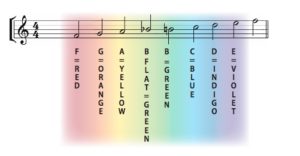The following article is adapted from an article written by Dr. Pert on Oct 2, 2004
Beautiful music is the art of the prophets that can calm the agitations of the soul; it is one of the most magnificent and delightful presents God has given us.
Martin Luther
Music, one might say, is the sound of spirit. Beautiful music can inspire, calm, and uplift us as it connects us to the innermost nature of our being. Surrendering to music may be the ultimate meditation. Music, like emotions, seems to bridge the gap between the material and spiritual realms. But, how does music heal? In short, by eliciting resonance in the bodymind.
Music directly vibrates cellular receptors, each of which operates an ion channel or controls a cellular signal. Thus you “hear” music with every cell of the body. As you are a field of information and energy, your receptors “hear” in the same frequency range as your ears, 20-2000 Hertz. Your receptors resonate with harmonics of the eliciting musical frequencies.
In the CD, “Healing the Hurting, Shining the Light”, there is an explanation of how light and colors are converted into sound waves using mathematical calculations to “enable a color-pitch harmonic transformation so that the range of visible light frequencies, traditionally associated with the Chakras all along the spinal cord, could be expressed in the human audible range.”
This ‘chakra music’ is used throughout the recording. Click below to experience a short excerpt:
Everything vibrates—matter, sound, light, energy. Beautiful music literally creates good health as the harmonious vibratory integration of the whole, inside and out.
Music entrains, re-programs and allows integration, via communication among component parts of the bodymind. It can overcome the mostly (unconscious) “blocks”—the repetitive patterns and habitual behaviors that arise from our expectations and beliefs, which we carefully store in our bodymind.
Using music with a mindfulness practice, breathing technique, guided imagery or positive affirmations can unlock those stored blockages and allow the free flow of the “wisdom of the body” that wants to heal itself. Music can initiate a whole host of nuanced and varied physiologic responses. Choose your music to set your dial to pleasure, bliss, and healing!
If you are interested in deeper concepts of how our brain processes musical sounds differently from other sounds, and a discussion of how music affects the coordinated functioning of the organism, check out Dr. Manfred Clynes book Music, Mind, and Brain: The Neuropsychology of Music.
For more traditional views of the power of music to calm anxiety, ease pain, and provide a pleasant diversion, for example during chemotherapy or a hospital stay, the Harvard Women’s Health Watch has published a short description of “Music Therapy”.


Leave a Reply